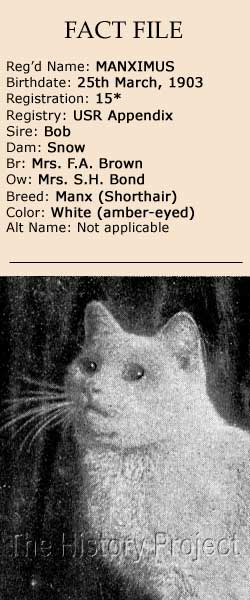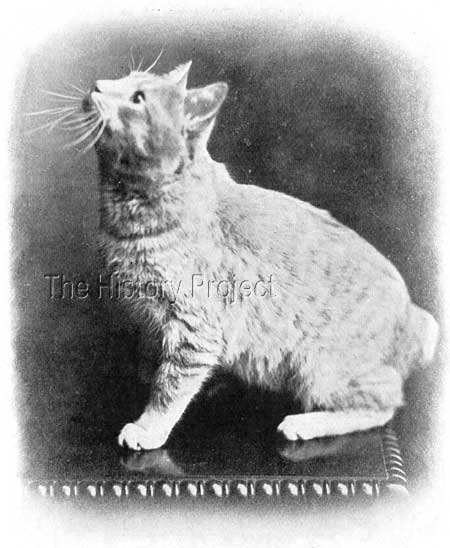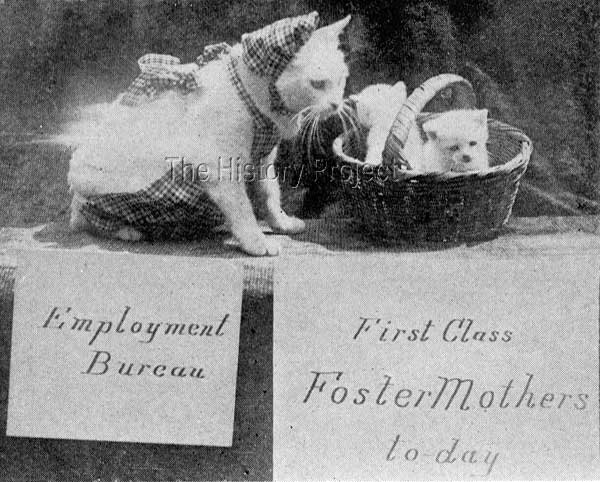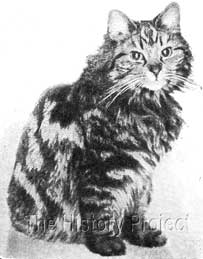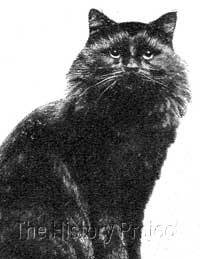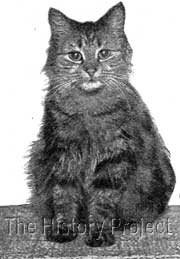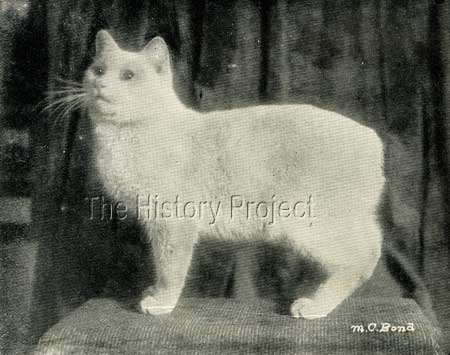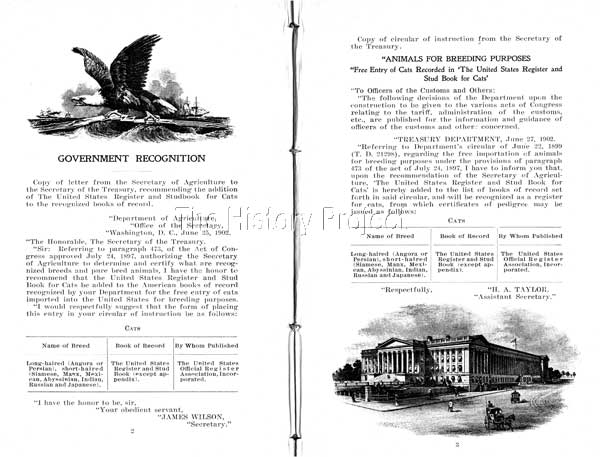 | ||||||||||||||||||||









|
MANIXMUS (1903)PHOTOS | SOCIAL MEDIA | REFERENCES
HISTORICAL BACKGROUND:The very early history of Manx cats, based in the United States during what was the infancy of the Cat Fancy there, is only sketchy at best. However, where there were major catteries, these breeders, although usually specialising in Persian or Angora cats, would often also dabble in alternative rare breeds, such as Siamese, English Shorthairs and occasionally Manx. These were the pioneers, and if it had four legs and purred, then they generally showed a genuine interest in it! Mrs. Clinton Locke (Adele), founder of the Beresford Cat Club, the oldest Cat Club in America, was among the first to import a Manx cat from the United Kingdom. Others who owned Manx included Mrs. F.A. Brown, and Mrs. S. Hazen Bond. Mrs. Samuel Hazen Bond (Mabel Cornish Bond) was situated in Washington, in the Capital District of Columbia where the seat of the U.S. Government was based. As a cattist, she wielded considerable influence on the eastern seaboard for a time as both a major breeder and importer of cats, and later, as the Registrar of the U.S. Register and Studbook for Cats, which was finally instituted in 1906 under the auspices of the United States Official Register Association. She was also a physician and parasitologist, and the founder and editor of The Fortnightly Cattarian, published 1903-1907. This too, was a publication of The United States Official Register Association. Mrs. S. Hazen Bond was also a regular American contributor to the English publication Our Cats, virtually from not long after its inception in late 1899, through to 1907. She also imported a number of cats from Britain, among them being the black Persian 'Menelik III' (circa March, 1898) who had been purchased from a street trader in London. Her black female, 'Sweet Lalla Rookh', (born 26th March, 1901) was also an import, known in England as 'Colleen'. She was bred by Mr. Robert Little, and was the first cat imported into the United States, free of duty under the new Tariff Law1.
PARENTAGE & OWNERSHIP:
Unknown
Bob, Black Manx
| Unknown
Manximus, Mar-25-1903, Amber-eyed White Manx, M
| Unknown
Snow, Odd-eyed White Shorthair (Manx)
Unknown
'Manximus' is among the earliest registered American-born Manx. He was born 25th March, 1903. His breeder was Mrs. F.A. Brown. His sire, was 'Bob', a Black Manx of unknown origin or pedigree and his dam was 'Snow' (USR:*9), who is recorded as a white shorthaired female, with one blue eye and one green eye. The owners of 'Snow' were Mrs. Woodcock, Miss Kate L. Gage, Mrs. A.J. Carleton and Mrs. F.A. Brown.¹ 'Manximus' was sold to Mrs. S. Hazen Bond. (M.C.Bond)1. SIBLINGS & SHOWS:The litter from 'Bob' and 'Snow' appears to have produced just two kittens, 'Manximus' who was registered as a white short-haired male, with 'No tail, no stump'; and 'Snow Baby', who was registered as a white short-haired female1.
Although we know that 'Manximus' was, in fact, a Manx, it is not clear whether his dam 'Snow' or his sibling 'Snow Baby' were also Manx or tailed cats. And even on his own registration he is described as a white short-hair, not as a white Manx with short hair! In the photo extant of his dam with her two kittens, there is nothing to indicate that she was a tailed cat, in fact, she looks like a Manx, but of this we cannot be certain, as the sire is described in brackets as a (Black Manx) while 'Snow" has not such description affixed to her name1. STOP PRESS: Within days of completing this file on 'Manximus', we discovered another photo taken at the same time as that immediately above, which we believe proves beyond question that his mother 'Snow' was in fact a 'tailed' cat. It comes from the 27th February 1904 edition of Our Cats in an article written by Mabel Cornish Bond on "Photographing Cats".
BREEDING & PROGENY:There are three recorded progeny of 'Manximus', all from one litter born 14th April, 1904. This litter was from a registered brown tabby longhair (Persian) female, named 'Shadu L'Mulk' (USR:21). This queen had been bred and was owned by Mrs. S. Hazen Bond, sired by her own black Persian male 'Menelik III' (USR:*31) and out of 'Roxana'(aka Khorassan Roxana),(USR:*2). Both parents had been brought from a vendor in London1. The progeny were 'Blanche', a white short-haired female, sold to Miss Ethel L. McSween of Falls Church, Virginia; 'Dink', a black short-haired male, sold to Miss Margaret McKenney, of 11th St, Washington D.C.; and 'Lily White', a white short-haired female, who was sold to Mrs. Agnes McSween, of G Street, N.W, Washington D.C.1 Although we have no images of the progeny themselves, we do have an image of their mother, and maternal grandparents.
As with the dam and sibling of 'Manximus' none of these three progeny are registered as Manx per se. So we have no clear way of knowing whether they were tailed or not, but must presume that they were tailed and hence registered plainly as 'short-haired'. PHOTOS:
SOCIAL MEDIA :
The above recognition made it possible for cats with registered pedigrees to be imported into the United States, exempt of Duty or Tariffs. On the page which lists the Officers, Directors and Executive Committee of the U.S. Official Register Association, is a listing of Associate Members appointed by American and Foreign Cat Clubs. Among them is Mrs. Gertrude B. Harris, appointed to represent 'The Manx Cat Club' based in the United States, and The Lady Alexander, appointed to represent 'The Manx Cat Club' based in the United Kingdom. In Summary: Perhaps, as this has been the story of an American-bred Manx cat, it is appropriate, that a word describing the Manx cat should come from the early American author of 'Concerning Cats', Helen M.Winslow, published by the Lothrop Publishing Company in 1900: "The Manx is considered by many people as a natural curiosity. It differs from the ordinary domestic cat but little, except in the absence of a tail, or even an apology for one. The hind legs are thicker and rather longer than the ordinary cat's, and it runs more like a hare. It is not a graceful object when seen from behind, but it is an affectionate, home-loving creature with considerable intelligence. The Manx cat came from the Isle of Man originally, and is a distinct breed. So-called Manx cats have tails from one to a few inches long, but these are crosses of the Manx and the ordinary cat."3 Very few Manx cats are recorded in the early American-based Registers, and those that are, are in the main, English bred cats owned by English fanciers. Mrs. Clinton Locke's 'Orange Manx' is not found in any register, which makes 'Manximus' the only early American-bred Manx for whom we have a partial pedigree, known parentage and progeny. A few years later, Jane Cathcart imported several Manx cats in an attempt to establish her own strain, but it was not until the 1930's that we can find an increasing number of Manx foundation cats being added to the CFA Studbook and Register. But Manx cats did not languish for long. During the mid to late 1930's through to the 1960's they came to the fore both in England and the United States, with the rise of cats such as 'Ginger of Manx of Glen Orry', (born in 1933) , 'Briargate Boy of Ramtal', (born in 1938), 'Prince of Manx of Glen Orry', (born in 1945), 'Bianco' (born in 1952) and on the later show circuit, 'Wila-Blite Pola of Silva-Wyte', (born in 1961) and exhibited by Richard (Dick) Gebhardt, and 'Tetra Taiga of Kellogg' (born in 1976) who became a GCCF Champion and CFA Grand Champion. This year, we watch with delight as a superlative red tabby and white Manx cat 'GC, RW Briar-Mar's Good To Be Me' (aka 'Manny'), rides a wave of success to the top of the standings on the United States show circuit. How wonderful it is to compare 'Manximus' to 'Manny' and to see how far this breed has developed in stature over 110 years. REFERENCES:
Registers associated with this article include The Incorporated Cat Fanciers Association of Great Britain (TICFAGB), National Cat Club (NCC), The Cat Club (CCR), Beresford Cat Club (BCC), Feline Federation Francaise (FFF), Siamese Cat Registry (SCR), US Register & Studbook for Cats (USR)including Supplement(USRS), The Studbook of the American Cat Association (ACA), and the Studbook & Register of the Cat Fanciers' Association (CFA).
|
|||||||||||||||||||
Home | Cats | Gallery | Clubs | People | Artifacts | Articles | Updates | Contact Us ©The CFA Foundation, Inc and The Harrison Weir Collection
|
||||||||||||||||||||
